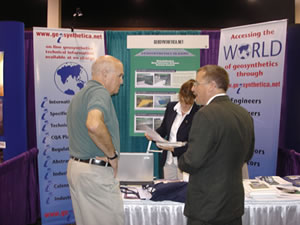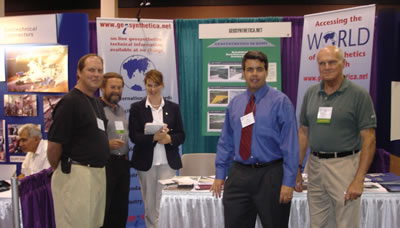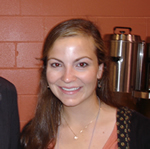The Association of State Dam Safety Officials (ASDSO) persevered through the destruction Hurricane Katrina imposed on New Orleans, Louisiana by moving their entire annual conference, Dam Safety 2005, to Orlando, Florida in just three days. The Disney Dolphin Hotel hosted the very well attended event two days earlier than originally scheduled. Kudos to the organizers for making such a smooth transition.
The program started on Friday, September 23rd with committee meetings and a welcome reception in the Exhibit Hall, where 58 booths (it seemed that only 3 remained unoccupied from the shift in location) were occupied by industry magazines, engineering firms, and government entities. geosynthetica held a booth displaying our Premium Underwriter materials and brochures. Many of the visiting engineers picked up samples of geomembrane, geogrid, and geocomposite, though the hottest items were the erosion control materials from North American Green and BBA’s Biobarrier® Root Control System and Typar geotextile. Bill Hawkins of BBA Fiberweb arrived mid-afternoon and took advantage of BBA’s Underwriter status and used geosynthetica’s space to talk to potential clients. geosynthetica offers its booth for Premium Underwriter meetings and table top space for Premium Underwriter material/brochure displays.
 |
| BBA Fiberweb’s Bill Hawkins speaking to Tom Roberts, Dam Safety Engineer, VA DCR – Division of Dam Safety about the benefits of Biobarrier®. |
On Saturday, Jay Swihart, US Bureau of Reclamations, and Ron Frobel, R. K. Frobel & Associates Consulting Engineers, stopped by the booth to chat. When asked if he had heard about geosynthetica’s full-day workshop on Geosynthetics in Dams, Jay replied with a big smile, "That’s why I’m here!" Obviously, our workshop wasn’t the only reason for Jay’s attendance, but we were very pleased to see him attending the session on Monday.
 |
| From left: Dave Paul, Ron Frobel, Elizabeth Peggs, Jay Swihart and Bill Hawkins, in front of gsa’s booth. |
Sunday was another exhibit day for geosynthetica. Lara Peggs manned the booth and fielded questions with Bill Hawkins about geosynthetics and their applications in and around dams, while Elizabeth Peggs covered the floor inviting dam engineers and designers to attend gsa’s Geosynthetics in Dams session the for the following day. The Annual Awards Banquet was held in the evening where one of the presentations went to Drexel student Theresa Andrejack. As a student in Drexel’s BS/MS program, Theresa has focused on geotechnical courses. Her senior design project was a collaborative redesign of the Upper Aetna Dam, one of several New Jersey dams that failed in July 2004, and her Master’s thesis is on axisymmetric testing of geosynthetics.
 |
| Student award winner Theresa Andrejack of Drexel University. |
 |
| Dianna Sheesley, VA DCR, and Elizabeth Peggs discussing the possibility of incorporating a geosynthetics workshop for a Virginia event in the future. |
Monday’s presentations were made to a very full room. The opening session with Jim Talbot and J.P. Giroud, who demonstrated the cons and pros (respectively) of using geosynthetics in dams, had an audience of ~180 conference attendees. Chairs had to be added partway through the presentations to accommodate the standing crowd accumulating in the back of the room.
 |
| Session I: J.P. Giroud countered Jim Talbot’s presentation, Issues on Using Geosynthetics in Dams (above) with his focus, Geosynthetics in Dams, 40 Years of Experience. |
Jim Talbot explained that while he has no objection to many materials in certain applications, he does, however, object strongly to using geotextiles as filters because of the issue of clogging. The main issue? "Fabrics clog much easier than sand filters…they don’t provide positive pressure on the soil seepage discharge face." He also feels that fabrics are "too fragile during installation" and that much "further testing and research is needed" before these materials should be used in this manner.
The focus of J.P.’s presentation was the essential function of seepage control. A brief history of successes, failures and lessons learned was demonstrated in his presentation, Geosynthetics in Dams, 40 Years of Experience. While he agreed with Jim that more research is needed, he countered many of Jim concerns with calculations and real-life experience in dams all over the world – many of them in Europe, where 90 of the 150 dams using geosynthetics exist. J.P. also put out a call to the geosynthetics community to reach out and inform the dam community of all the work that has been done, and is being done to further a meeting of the minds where geosynthetics and dams are concerned.
After a brief break, Session II started with Alberto Scuero’s presentation on ICOLD’s Bulletins number 38 (Use of Thin Membranes on Fill Dams) and 78 ( Watertight Geomembranes for Dams). Jorge Zornberg followed with a focus on waterproofing, after opening with the question, "Why do we need to conserve water?" Deborah Miller closed Session II with several case studies of geosynthetics use in dams.
Elizabeth Peggs has asked geosynthetica.net Underwriters to participate in Session III of the workshop by offering case studies using their products in dam applications. CETCO’s Jim Olsta, North American Green’s Roy Nelsen, Coletanche’s Bernard Breul, and BBA’s Bill Hawkins all presented before the closing Q&A session. Jim Talbot took the opportunity here to make a quick rebuttal to J.P.’s previous statements, to which J. P. took to the podium for his own rebuttal! The good-natured discussion was informative and gave everyone a good idea of the work that remains to be done in forging a better geosynthetics/dam relationship – or a dam geosynthetic relationship! The dam jokes do make their appearances at these dam events.
 |
| Jim Talbot and J. P. Giroud taking turns at the podium during theworkshop’s Q&A. Organizer Eric Ditchey seated at table. |
geosynthetica and the organizers of the workshop considered it a huge success and are looking forward to expanding on this program for next year’s conference. We’d like to extend a thank you to Eric Ditchy of McCormick Taylor, Inc., for putting together the sessions with Elizabeth Peggs. If you are interested in participating with our effort to bring the geosynthetics and dam communities closer together, please contact Elizabeth with your ideas and suggestions for ASDSO 2006.
Below is the 2005 Workshop on Geosynthetics Program which includes links to many of the authors’ presentations:
Workshop on Geosynthetics
Session I: Geosynthetics in Dams: Issues and Solutions
Issues on Using Geosynthetics on Dams, James R. Talbot, Senior Technical Manager, GEI Consultants
Geosynthetics in Dams, 40 Years of Experience, J. P. Giroud, J. P. Giroud, Inc.
Session II: Current Research and Applications
New ICOLD Bulletin: Geomembranes Sealing Systems for Dams: Design Principles and Experience, Alberto Scuero, ICOLD European Working Group on Geomembranes
Use of Geosynthetics in Dam Waterproofing, Jorge G. Zornberg, The University of Texas at Austin
Geosynthetics Applications and Performance Reviews – Select Case Histories, Debora J. Miller, Gannett Fleming, Inc., et al
presentation (PowerPoint)
full paper (Adobe Acrobat)
Session III: Geosynthetics Applications – Case Histories
Dam Rehabilitation Using Geosynthetic Clay Liners, Jim Olsta and Don Carine, CETCO
presentation (PowerPoint)
full paper (Adobe Acrobat)Geosynthetically Reinforced Vegetation: Proven & Engineered System for Protecting Spillways Against Erosive Forces, Roy J. Nelson, North American Green
The Use of Bituminous Geomembrane Liners to Watertight Dams Higher than 65 Feet: A 27 Year History, Bernard Breul, Coletanche, Ltd.
The Use of Geosynthetic Materials to Prevent Root Intrusion in Dams: A Case History, William Hawkins, BBA Fiberweb











